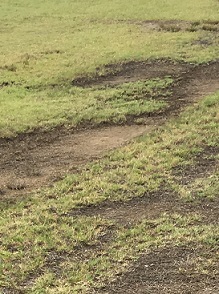Learn to identify Turf Grasses to suit your needs
- Make better decisions to establish those turf grasses
- Learn how to better maintain different cultivators
- Understand what can go wrong with a turf surface
 Course Content
Course Content
There are ten lessons:
- Introduction
- Fescues
- Bentgrasses
- Ryegrasses
- Bluegrasses
- Couchgrasses
- Buffalo and Zoysia Grasses
- Other Warm Condition Grasses
- Other Cool Condition Grasses
- Turfgrass Blends
Aims
- Recognise characteristics that differentiate different cultivars
- Make better choices about what cultivars are appropriate for different turf applications.
- Describe the characteristics, culture and uses of Fescue grasses as a turf.
- Describe the characteristics, culture and uses of Bent grasses as a turf.
- Describe the characteristics, culture and uses of Rye grasses as a turf.
- Describe the characteristics, culture and uses of Blue grasses as a turf.
- Describe the characteristics, culture and uses of Couch grasses as a turf.
- Describe the characteristics, culture and use of Buffalo and Zoysia grasses.
- Describe the characteristics, culture and uses of various warm condition grasses as a turf.
- Describe the characteristics, culture and uses of various cool condition grasses as a turf.
- Explain how different turf grass cultivars can be blended together.
Different Grasses Do Grow Differently!
A lawn or paddock of grass may consist of one, or several species of identifiable grasses. Over time the grass have tillered and spread by stolon or rhizome to become tightly interwoven. The independent plant of a grass has several basic characteristics.
When it germinates, the seed has one cotyledon (or one first leaf) and the mature leaves have parallel veins both of which indicate it is scientifically referred to as a monocotyledon.
As it grows, one can see that it has a stem that bears leaves and a flower head, all of which is known as the ‘culm’. Beneath the culm is the fibrous root system.
Grasses most commonly grow erect/upright, forming clumps. They spread by any of the following three methods:
- Tillering: this is where as a result of a compressed stem, a new plant is produced at the base of the present culm. In time this gives the grass a tufted appearance. The number of tillers produced is governed by the genetic characteristics and environment conditions.
- Stolons: this is where stems are sent above the ground to reproduce a "daughter" plant nearby. Genetically it is the same as the parent. At nodes along the stolon that come in contact with the ground, adventitious roots are produced giving rise to a new plant.
- Rhizomes: these are stems which bare scale like leaves and grow below the ground, sprouting occasionally through the surface to produce new plants.
WHO WILL BENEFIT FROM DOING THIS COURSE?
- Professional Development for gardeners, greenkeepers, sports ground managers, parks managers, or contractors.
- Training for an advantage over the competition for anyone starting a career in horticulture or landscaping.